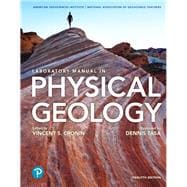For introductory geology courses.
Build 21st century skills with new 3D media experiences
Laboratory Manual in Physical Geology offers an inquiry and activities-based approach that builds skills and gives students a complete learning experience in the lab. This user-friendly lab manual examines the basic processes of geology and their applications to everyday life, featuring an exceptional illustration program by Dennis Tasa and contributions from over 200 highly regarded geologists and geoscience educators.
With the 12th Edition, lead author Vince Cronin and the newly formed NAGT editorial panel deliver the latest data and science, including new climate/environmental change and hazards/disasters lab activities.
Now available with Modified Mastering Geology
By combining trusted author content with digital tools and a flexible platform, Mastering personalizes the learning experience and improves results for each student. Mastering Geology extends learning and provides students with a platform to practice, learn, and apply knowledge outside of the classroom.
Note: You are purchasing a standalone product; Mastering Geology does not come packaged with this content. Students, if interested in purchasing this title with Mastering Geology, ask your instructor for the correct package ISBN and Course ID. Instructors, contact your Pearson representative for more information.
If you would like to purchase both the physical text and Modified Mastering Geology, search for:
0135836859 / 9780135836859 Laboratory Manual in Physical Geology Plus Modified Mastering Geology with Pearson eText -- Access Card Package, 12/e
Package consists of:
- 0135870380 / 9780135870389 Modified Mastering Geology with Pearson eText -- ValuePack Access Card -- for Laboratory Manual in Physical Geology, 12/e
- 0135836972 / 9780135836972 Laboratory Manual in Physical Geology, 12/e









